Inscriptions
Browse the RIAo Corpus [http://oracc.museum.upenn.edu/riao/pager/]
1
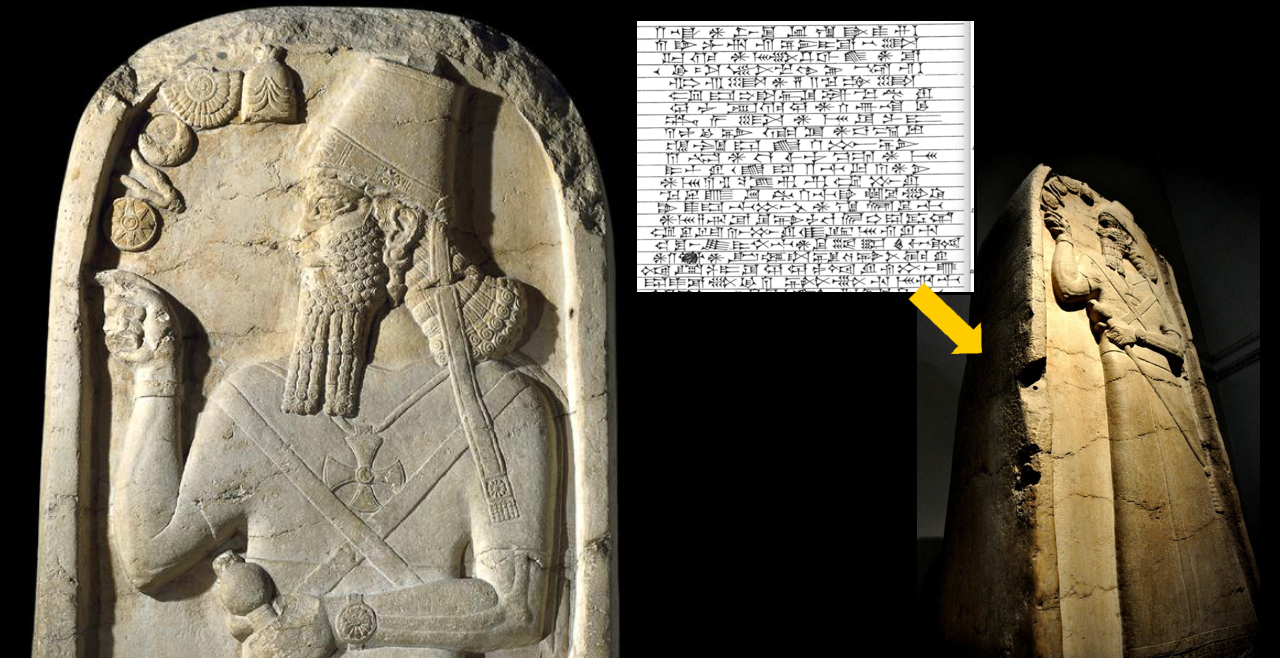
BM 115020 © The Trustees of the British Museum
A large stone stele depicting king Šamšī-Adad V and divine symbols
in relief, was discovered by Rassam in the Nabû temple at Nimrud,
although it must have originally been installed in the temple of the
same city dedicated to Ninurta, as the text engraved on it is dedicated to this god. The text is inscribed on the sides and on the back of the monument, and is written with an "archaic" script very similar to the one used by the scribes of Samsī-Addu
I [/riao/fromsamsiaddutomittanicilent18081364bc/samsiaddudynasty/samsiaddui/index.html] (ca. 1808-1776 BC) and other ancient rulers. A stone fragment from Nineveh (ex. 2) is engraved with an inscription that duplicates the one on the Nimrud stele in both content and ductus, and was possibly destined to the Nineveh Ištar temple.
The text opens with a long dedication to the god Ninurta (i 1-25),
followed by the name, epithets and genealogy of Šamšī-Adad V (i
26-38). Lines i 39-53a are dedicated to the description of the
rebellion against Šamšī-Adad's father, Shalmaneser
III [/riao/theassyrianempire883745bc/shalmaneseriii/index.html], and how it was suppressed by the new ruler. This
passage is followed by the description of the first four military
campaigns of Šamšī-Adad V, with no indication of regnal years: a
campaign against Nairi (i 53b-ii 16a); a second campaign against
Nairi, but led by the chief eunuch (ii 16b-34a); a third campaign
against Nairi and the Medes (ii 34b-iii 70a); a campaign against
Babylonia (iii 70b-iv 45). The inscription ends abruptly, without a building section or concluding blessing and curses. J. Reade suggested (in Fales, ARIN, pp. 150-151) that the stele was originally erected beside a temple platform and inscribed in situ, and the presence of the platform prevented the scribe to finish the text. This campaign should be dated to 814 BC, and therefore the stele must be dated to 813 BC or later.
The successive two campaigns are described in text no. 2, a stone fragment from Ashur, which, although badly worn, clearly text no. 1 in its first part. A second fragment from Ashur, text no. 3, seems also to duplicate parts of the text edited here, but it is almost totally illegible.
Access the composite text [http://oracc.museum.upenn.edu/riao/Q004738/] of Šamšī-Adad V 01.
Bibliography
2
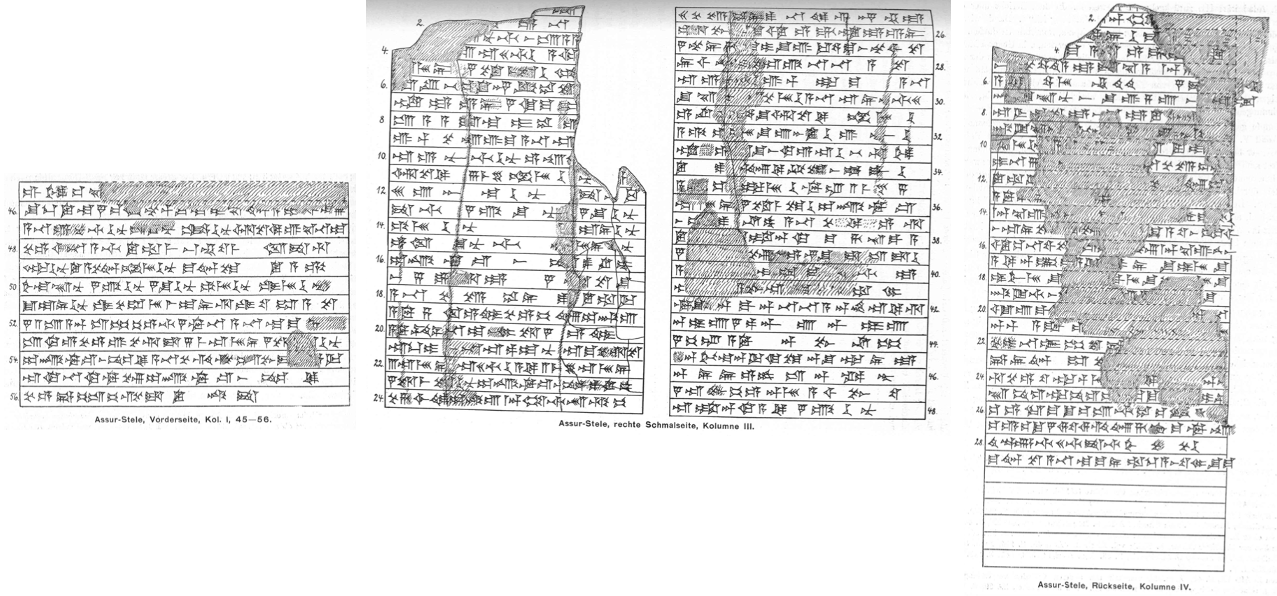
Weidner, AfO 9 pp. 89-101
A broken stone stele was found at the Anu-Adad temple in Ashur. It is engraved with a badly worn inscription, which is very difficult to read, especially in its columns i, ii and iv. However, the decipherment of the few readable traces of columns i and ii have confirmed that they are duplicates of parts of text no. 1. These parts are treated as exemplar no. 3 of text no. 1:
Text no. 2 i 2-56 = text no. 1 i 41-iii 4
Text no. 2 ii last ten lines =. Text no. 1 iv 36-4
Column iii on the right, narrow side of the fragment, is easier to read, and its edition is presented here. This text is a fortunate addition to text no. 1, which was interrupted in the middle of the account of Šamšī-Adad's fourth campaign, and it records the fifth and the sixth campaign of this ruler. Then, at line iv 29, the text begins with a new paragraph introduced by the sentence ina ūmišuma "at that time," followed by six ruled empty lines, showing that the inscription was never finished.
Access the composite text [http://oracc.museum.upenn.edu/riao/Q004739/] of Šamšī-Adad V 02.
Bibliography
3
Another stone stela from Ashur duplicates – as it was reconstructed by Schramm – parts of text no. 1, namely iii 18-31. The stela was found in the Aššur temple at Ashur, and it was probably dedicated to this god. The only sources for the collation of the inscription is a virtually illegible photo, and for this reason no edition is presented here.
Bibliography
4 - "Letter from the god Aššur"
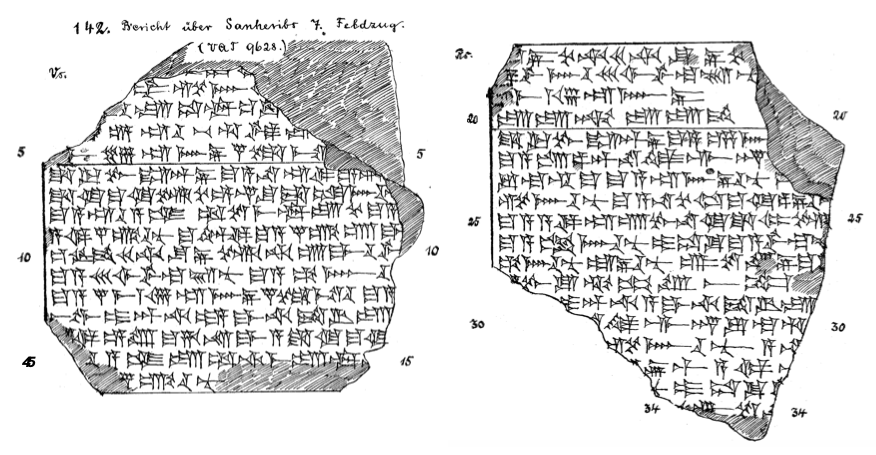
KAH 2 no. 142
A fragment of a clay tablet from Ashur is inscribed with part of a "letter from a god," most probably Aššur addressed to Šamšī-Adad V. The format of the text is based, like for other similar examples of this particular genre, on the repetition of the records of the events, just like what happens in the letters from the royal correspondence. First the god quotes ("With regard to what you wrote to me, as follows: '[I marched] to Dēr...' ") the report on a campaign as given by the king. Then the god confirm the validity of the king's action and repeats the report in the second person ("By the command of my great divinity it came about that: [You marched to Dēr].")
The survived portion of the text begins in the midst of the narrative of the fifth campaign (lines 1'-20'), which can be partly reconstructed through comparison with text no. 2 (iii 29'-48'// text no. 4: 2'-9'). The text, then, continues with what is probably the account of the sixth campaign, although it does not match with what reported in text no. 2 (iv 11'-29').
Access the composite text [http://oracc.museum.upenn.edu/riao/Q004741/] of Šamšī-Adad V 04.
Bibliography
5
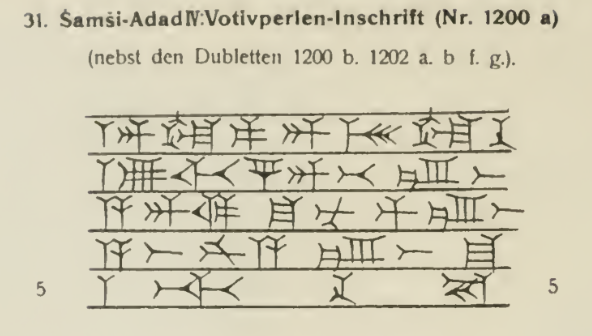
KAH 1 no. 31
This text is a dedicatory inscription to the goddess Bēlat-parṣi inscribed on a small cylinder found at Ashur.
Access the composite text [http://oracc.museum.upenn.edu/riao/Q004742/] of Šamšī-Adad V 05.
Bibliography
6
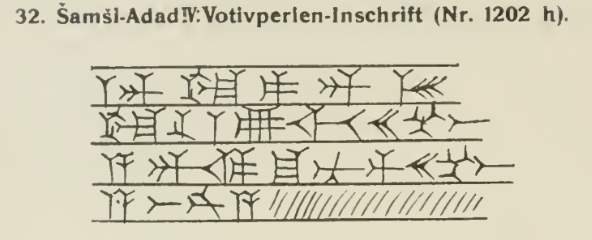
KAH 1 no. 32
This text is a dedicatory inscription to the goddess Bēlat-parṣi inscribed on a small cylinder found at Ashur.
Access the composite text [http://oracc.museum.upenn.edu/riao/Q004743/] of Šamšī-Adad V 06.
Bibliography
7
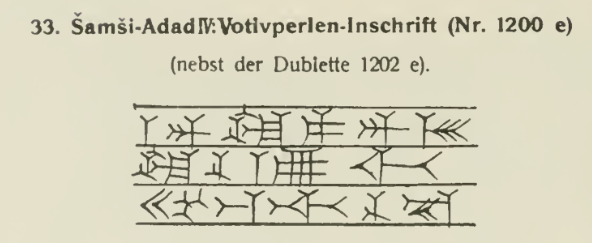
KAH 1 no. 33
This text is a dedicatory inscription to the goddess Bēlat-parṣi inscribed on a small cylinder found at Ashur. Although Šamšī-Adad V does not mention his predecessors in this text, it clearly belongs to him since it is very similar to the texts no. 5 [http:/riao/theassyrianempire883745bc/shamshiadadv/inscriptions/index.html#shamshiadad505] and 6. [http:/riao/theassyrianempire883745bc/shamshiadadv/inscriptions/index.html#shamshiadad506]
Access the composite text [http://oracc.museum.upenn.edu/riao/Q004744/] of Šamšī-Adad V 07.
Bibliography
8
This text is a dedicatory inscription to the goddess Bēlat-parṣi inscribed on a small limestone cylinder found at Ashur. The inscription represents a shorter version of the texts no. 5 [http:/riao/theassyrianempire883745bc/shamshiadadv/inscriptions/index.html#shamshiadad505], 6 [http:/riao/theassyrianempire883745bc/shamshiadadv/inscriptions/index.html#shamshiadad506] and 7 [http:/riao/theassyrianempire883745bc/shamshiadadv/inscriptions/index.html#shamshiadad507].
Access the composite text [http://oracc.museum.upenn.edu/riao/Q004745/] of Šamšī-Adad V 08.
Bibliography
9
This palace foundation inscription is attested on bricks found at Nineveh and at Ashur, one of which was discovered with the sarcophagus of Šamšī-Adad V, as well as on a piece of a clay cone found at Nineveh and on the sarcophagus of the king. Šamšī-Adad V calls himself „king of Sumer (and) Akkad", which indicates that the text was composed after he started invading Babylonia (ca. 814-811 BC), i.e. late in the reign. This is confirmed by the fact that the text was engraved on his sarcophagus (Grayson 1996 RIMA 3 p. 197)
Access the composite text [http://oracc.museum.upenn.edu/riao/Q004746/] of Šamšī-Adad V 09.
Bibliography
10
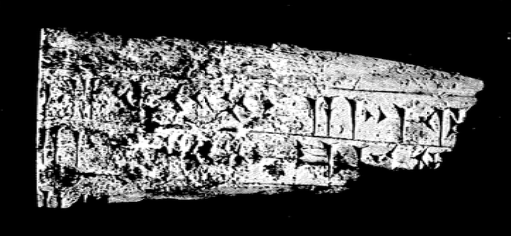
Mallowan, Nimrud 2 p. 596
This broken text is attested on a piece of an ivory strip found at Calah. The preserved part contains the genealogy of Šamšī-Adad V.
Access the composite text [http://oracc.museum.upenn.edu/riao/Q004747/] of Šamšī-Adad V 10.
Bibliography
2001
This text is inscribed on an amulet of blue stone found at Byblos. According to the inscription, the amulet is a property of Ili-ittīya, a eunuch of Šamšī-Adad V. Only the first three lines, which record the owner and the titles of Šamšī-Adad V, are edited here. The rest of the inscription contains incantations.
Access the composite text [http://oracc.museum.upenn.edu/riao/Q004748/] of Šamšī-Adad V 2001.
Bibliography
Nathan Morello & Alexander Kudryavtsev
Nathan Morello & Alexander Kudryavtsev, 'Inscriptions', The Royal Inscriptions of Assyria online (RIAo) Project, The RIAo Project, a sub-project of MOCCI, 2020 [http://oracc.museum.upenn.edu/riao/theassyrianempire883745bc/shamshiadadv/inscriptions/]